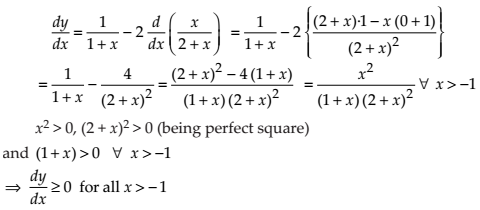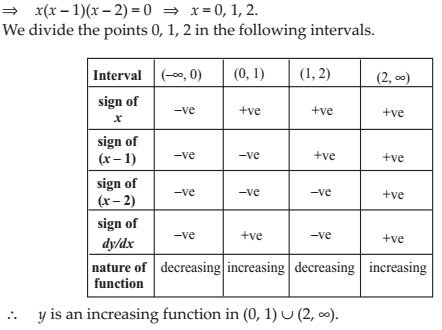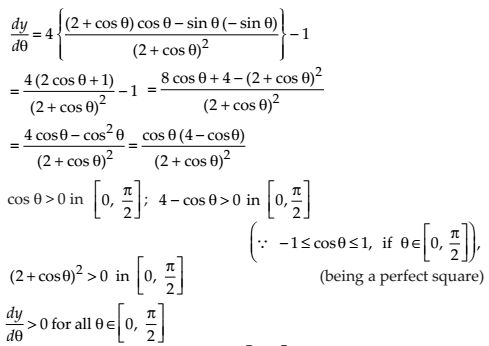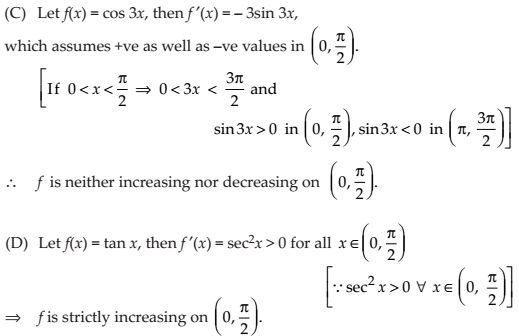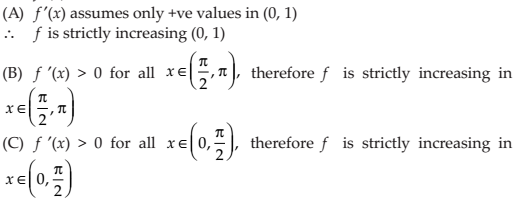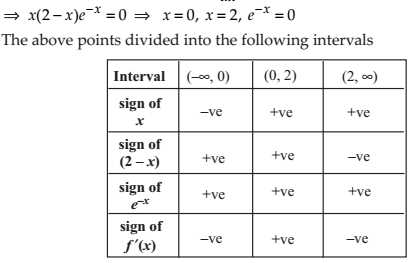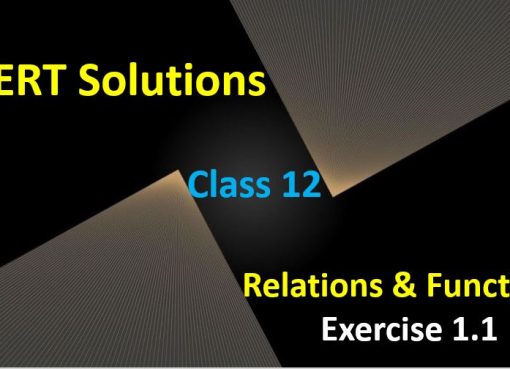NCERT Solutions for Class 12 Maths Application of Derivatives
Hi Students, Welcome to Amans Maths Blogs (AMB). In this post, you will get the NCERT Solutions for Class 12 Maths Application of Derivative Exercise 6.2.
NCERT Solutions for Class 12 Maths are not only the solutions of Maths exercise but it builds your foundation of other important subjects. Getting knowledge of depth concept of CBSE Class 12th Maths like Algebra, Calculus, Trigonometry, Coordinate Geometry help you to understand the concept of Physics and Physical Chemistry.
As we know that all the schools affiliated from CBSE follow the NCERT books for all subjects. You can check the CBSE NCERT Syllabus. Thus, NCERT Solutions helps the students to solve the exercise questions as given in NCERT Books.
CBSE Class 12th is an important school class in your life as you take some serious decision about your career. And out of all subjects, Maths is an important and core subjects. So CBSE NCERT Solutions for Class 12th Maths is major role in your exam preparation as it has detailed chapter wise solutions for all exercise. This NCERT Solutions can be downloaded in PDF file. The downloading link is given at last.
The PDF books of NCERT Solutions for Class 12 are the first step towards the learning and understanding the each sections of Maths, Physics, Chemistry, Biology as it all help in engineering medical entrance exams. To solve it, you just need to click on download links of NCERT solutions for class 12.
NCERT Solutions for class 12 is highly recommended by the experienced teacher for students who are going to appear in CBSE Class 12 and JEE Mains and Advanced and NEET level exams. Here You will get NCERT Solutions for Class 12 Maths Application of Derivative Exercise 6.2 of all questions given in NCERT textbooks of class 12 in details with step by step process.
NCERT Solutions for Class 12 Maths Application of Derivatives Exercise 6.2
NCERT Solutions for Class 12 Maths Application of Derivatives Exercise 6.2: Ques No 1.
Show that the function given by f (x) = 3x + 17 is strictly increasing on R.
NCERT Solutions:
We are given that f(x) = 3x + 17.
Since f(x) is a polynomial, it is continuous and differential in R.
On differentiating f(x) with respect to x, we get f ‘(x) = 3 > 0 for all x ∊ R.
Thus, f(x) = 3x + 17 is an strictly increasing function on R.
NCERT Solutions for Class 12 Maths Application of Derivatives Exercise 6.2: Ques No 2.
Show that the function given by f (x) = e2x is strictly increasing on R.
NCERT Solutions:
We are given that f(x) = e2x.
Since f(x) is an exponential function, it is continuous and differential in R.
On differentiating f(x) with respect to x, we get f ‘(x) = e2x . 2 = 2e2x > 0 for all x ∊ R.
Thus, f(x) = e2x is an strictly increasing function on R.
NCERT Solutions for Class 12 Maths Application of Derivatives Exercise 6.2: Ques No 3.
Show that the function given by f (x) = sin x is
(a) strictly increasing in (0, π/2)
(b) strictly decreasing in (π/2, π)
(c) neither increasing nor decreasing in (0, π)
NCERT Solutions:
We are given that f(x) = sin x.
Since f(x) is a sine function, it is continuous and differential in R.
On differentiating f(x) with respect to x, we get f ‘(x) = cos x.
(a) In x ∊ (0, π/2), cos x > 0 ⇒ f ‘(x) > 0
Thus, f(x) = sin x is an strictly increasing function on x ∊ (0, π/2).
(b) In x ∊ (π/2, π), cos x < 0 ⇒ f ‘(x) < 0
Thus, f(x) = sin x is an strictly decreasing function on x ∊ (π/2, π).
(c) In x ∊ (0, π/2), we have f ‘(x) > 0 and in x ∊ (π/2, π), we have f ‘(x) < 0.
Thus, the given function f(x) = sin x is neither increasing nor decreasing in (0, π).
NCERT Solutions for Class 12 Maths Application of Derivatives Exercise 6.2: Ques No 4.
Find the intervals in which the function f given by f (x) = 2x2 – 3x is
(a) strictly increasing
(b) strictly decreasing
NCERT Solutions:
We are given that f(x) = 2x2 – 3x.
Since f(x) is a polynomial, it is continuous and differential in R.
On differentiating f(x) with respect to x, we get f ‘(x) = 4x – 3.
(a) For strictly increasing f ‘(x) > 0 ⇒ 4x – 3 > 0 ⇒ x > 3/4 ⇒ x ∊ (3/4, ∞).
Thus, the given function f(x) = 2x2 – 3x is strictly increasing in x ∊ (3/4, ∞).
(b) For strictly decreasing f ‘(x) < 0 ⇒ 4x – 3 < 0 ⇒ x < 3/4 ⇒ x ∊ (-∞, 3/4).
Thus, the given function f(x) = 2x2 – 3x is strictly decreasing in x ∊ (-∞, 3/4).
NCERT Solutions for Class 12 Maths Application of Derivatives Exercise 6.2: Ques No 5.
Find the intervals in which the function f given by f (x) = 2x3 – 3x2 – 36x + 7 is
(a) strictly increasing
(b) strictly decreasing
NCERT Solutions:
We are given that f(x) = 2x3 – 3x2 – 36x + 7.
Since f(x) is a polynomial, it is continuous and differential in R.
On differentiating f(x) with respect to x, we get
f ‘(x) = 6x2 – 6x – 36 = 6(x2 – x – 6) = 6(x – 3)(x + 2).
(a) For strictly increasing f ‘(x) > 0 ⇒ 6(x – 3)(x + 2) > 0 ⇒ x < -2 OR x > 3 ⇒ x ∊ (-∞, -2) U (3, ∞).
Thus, the given function f(x) = 2x3 – 3x2 – 36x + 7 is strictly increasing in x ∊ (-∞, -2) U (3, ∞).
(b) For strictly decreasing f ‘(x) < 0 ⇒ 6(x – 3)(x + 2) < 0 ⇒ -2 < x < 3 ⇒ x ∊ (-2, 3).
Thus, the given function f(x) = 2x3 – 3x2 – 36x + 7 is strictly decreasing in x ∊ (-2, 3).
NCERT Solutions for Class 12 Maths Application of Derivatives Exercise 6.2: Ques No 6.
Find the intervals in which the following functions are strictly increasing or decreasing
(a) x2 + 2x – 5
NCERT Solutions:
We are given that f(x) = x2 + 2x – 5.
Since f(x) is a polynomial, it is continuous and differential in R.
On differentiating f(x) with respect to x, we get
f ‘(x) = 2x + 2 = 2(x + 1).
For strictly increasing f ‘(x) > 0 ⇒ 2(x + 1) > 0 ⇒ x > -1 ⇒ x ∊ (-1, ∞).
Thus, the given function f(x) = x2 + 2x – 5 is strictly increasing in x ∊ (-1, ∞).
For strictly decreasing f ‘(x) < 0 ⇒ 2(x + 1) < 0 ⇒ x < -1 ⇒ x ∊ (-∞, -1).
Thus, the given function f(x) = x2 + 2x – 5 is strictly decreasing in x ∊ (-∞, -1).
(b) 10 – 6x – 2x2
NCERT Solutions:
We are given that f(x) = 10 – 6x – 2x2.
Since f(x) is a polynomial, it is continuous and differential in R.
On differentiating f(x) with respect to x, we get
f ‘(x) = -6 – 4x = -4(x + 3/2).
For strictly increasing f ‘(x) > 0 ⇒ -4(x + 3/2) > 0 ⇒ (x + 3/2) < 0 ⇒ x < -3/2 ⇒ x ∊ (-∞, -3/2).
Thus, the given function f(x) = 10 – 6x – 2x2 is strictly increasing in x ∊ (-∞, -3/2).
For strictly decreasing f ‘(x) < 0 ⇒ -4(x + 3/2) < 0 ⇒ (x + 3/2) > 0 ⇒ x > -3/2 ⇒ x ∊ (-3/2, ∞).
Thus, the given function f(x) = 10 – 6x – 2x2 is strictly decreasing in x ∊ (-3/2, ∞).
(c) –2x3 – 9x2 – 12x + 1
NCERT Solutions:
We are given that f(x) = –2x3 – 9x2 – 12x + 1.
Since f(x) is a polynomial, it is continuous and differential in R.
On differentiating f(x) with respect to x, we get
f ‘(x) = -6x2 – 18x – 12 = -6(x2 + 3x + 2) = -6(x + 2)(x + 1).
For strictly increasing
f ‘(x) > 0 ⇒ -6(x + 2)(x + 1) > 0 ⇒ (x + 2)(x + 1) < 0 ⇒ -2 < x < -1 ⇒ x ∊ (-2, -1).
Thus, the given function f(x) = –2x3 – 9x2 – 12x + 1 is strictly increasing in x ∊ (-2, -1).
For strictly decreasing
f ‘(x) > 0 ⇒ -6(x + 2)(x + 1) < 0 ⇒ (x + 2)(x + 1) > 0 ⇒ x < -2 OR x > -1 ⇒ x ∊ (-∞, -2) U (-1, ∞).
Thus, the given function f(x) = –2x3 – 9x2 – 12x + 1 is strictly decreasing in x ∊ (-∞, -2) U (-1, ∞).
(d) 6 – 9x – x2
NCERT Solutions:
We are given that f(x) = 6 – 9x – x2.
Since f(x) is a polynomial, it is continuous and differential in R.
On differentiating f(x) with respect to x, we get
f ‘(x) = -9 – 2x = -2(x + 9/2).
For strictly increasing
f ‘(x) > 0 ⇒ -2(x + 9/2) > 0 ⇒ (x + 9/2) < 0 ⇒ x < -9/2 ⇒ x ∊ (-∞, -9/2).
Thus, the given function f(x) = 6 – 9x – x2 is strictly increasing in x ∊ (-∞, -9/2).
For strictly decreasing
f ‘(x) < 0 ⇒ -2(x + 9/2) < 0 ⇒ (x + 9/2) > 0 ⇒ x > -9/2 ⇒ x ∊ (-9/2, ∞).
Thus, the given function f(x) = 6 – 9x – x2 is strictly decreasing in x ∊ (-9/2, ∞).
(e) (x + 1)3(x – 3)3
NCERT Solutions:
We are given that f(x) = (x + 1)3(x – 3)3.
Since f(x) is a polynomial, it is continuous and differential in R.
On differentiating f(x) with respect to x, we get
f ‘(x) = 3(x + 1)2 . (x – 3)3 + (x + 1)3 .3(x – 3)2
= 3(x + 1)2(x – 3)2(x – 3 + x + 1)
= 3(x + 1)2(x – 3)2(2x – 2)
= 6(x + 1)2(x – 3)2(x – 1)
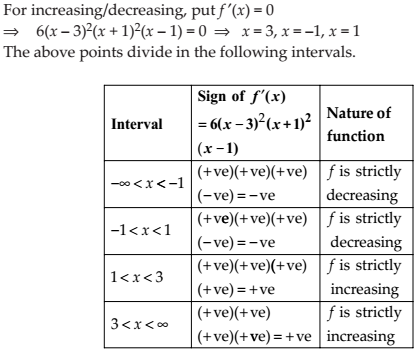
NCERT Solutions for Class 12 Maths Application of Derivatives Exercise 6.2: Ques No 7.
Show that y = log(1 + x) – 2x/(2 + x), x > – 1, is an increasing function of x throughout its domain.
NCERT Solutions:
We are given that
On differentiating with respect to x, we get
Thus, the given function y = log(1 + x) – 2x/(2 + x), x > – 1, is an increasing function of x throughout its domain.
NCERT Solutions for Class 12 Maths Application of Derivatives Exercise 6.2: Ques No 8.
Find the values of x for which y = [x(x – 2)]2 is an increasing function.
NCERT Solutions:
We are given that y = [x(x – 2)]2 = (x2 – 2x)2.
On differentiating with respect to x, we get
For increasing or decreasing, put dy/dx = 0
NCERT Solutions for Class 12 Maths Application of Derivatives Exercise 6.2: Ques No 9.
Prove that y = 4sin θ / (2 + cos θ) – θ is an increasing function of θ in [0, π2].
NCERT Solutions:
We are given that y = 4sin θ / (2 + cos θ) – θ.
On differentiating with respect to x, we get
Thus, the given function y = 4sin θ / (2 + cos θ) – θ is increasing function of θ in [0, π2].
NCERT Solutions for Class 12 Maths Application of Derivatives Exercise 6.2: Ques No 10.
Prove that the logarithmic function is strictly increasing on (0, ∞).
NCERT Solutions:
We are given that y = log x. Its domain is (0, ∞).
On differentiating with respect to x, we get
Thus, the logarithmic function y = log x is increasing function of θ in (0, ∞).
NCERT Solutions for Class 12 Maths Application of Derivatives Exercise 6.2: Ques No 11.
Prove that the function f given by f (x) = x2 – x + 1 is neither strictly increasing nor strictly decreasing on (– 1, 1).
NCERT Solutions:
We are given that y = f(x) = x2 – x + 1.
On differentiating with respect to x, we get
f ‘(x) = 2x – 1
For increasing, f ‘(x) > 0 ⇒ 2x – 1 > 0 ⇒ x > 1/2.
For decreasing, f ‘(x) < 0 ⇒ 2x – 1 < 0 ⇒ x < 1/2.
Thus, the given function is neither strictly increasing nor strictly decreasing on (– 1, 1).
NCERT Solutions for Class 12 Maths Application of Derivatives Exercise 6.2: Ques No 12.
Which of the following functions are strictly decreasing on (0, π/2)?
(A) cos x
(B) cos 2x
(C) cos 3x
(D) tan x
NCERT Solutions:
(A)
We are given that y = f(x) = cos x.
On differentiating with respect to x, we get
f ‘(x) = -sin x
Since f ‘(x) = -sin x < 0 for all x ∊ (0, π/2).
Thus, the given function is strictly decreasing on (0, π/2).
(B)
We are given that y = f(x) = cos 2x.
On differentiating with respect to x, we get
f ‘(x) = -2sin 2x
Since f ‘(x) = -2sin 2x < 0 for all x ∊ (0, π/2). As
Thus, the given function is strictly decreasing on (0, π/2).
Therefore, the functions in (A) and (B) are strictly decreasing in (0, π/2).
NCERT Solutions for Class 12 Maths Application of Derivatives Exercise 6.2: Ques No 13.
On which of the following intervals is the function f given by f (x) = x100 + sin x –1 strictly decreasing ?
(A) (0,1)
(B) (π/2, π)
(C) (0, π/2)
(D) None of these
NCERT Solutions:
We are given that y = f(x) = x100 + sin x –1.
On differentiating with respect to x, we get
Since the given function is NOT decreasing in any of the intervals, hence the correct answer is D.
NCERT Solutions for Class 12 Maths Application of Derivatives Exercise 6.2: Ques No 14.
Find the least value of a such that the function f given by f (x) = x2 + ax + 1 is strictly increasing on (1, 2).
NCERT Solutions:
We are given that y = f(x) = x2 + ax + 1.
On differentiating with respect to x, we get f ‘(x) = 2x + a.
Given that 1 < x < 2 ⇒ 2 < 2x < 4 ⇒ (2 + a) < 2x + a < (4 + a) ⇒ (2 + a) < f ‘(x) < (4 + a).
Now f(x) is strictly increasing on (1, 2) then f ‘(x) > 0 for 1 < x < 2.
⇒ (2 + a) ≧ 0 ⇒ a ≧ -2. Thus, required least value of a is -2.
NCERT Solutions for Class 12 Maths Application of Derivatives Exercise 6.2: Ques No 15.
Let I be any interval disjoint from (–1, 1). Prove that the function f given by f(x) = x + 1/x is strictly increasing on I.
NCERT Solutions:
We are given that y = f(x) = x + 1/x.
On differentiating with respect to x, we get
Since I is an interval which is a subset of R – (-1, 1).
NCERT Solutions for Class 12 Maths Application of Derivatives Exercise 6.2: Ques No 16.
Prove that the function f given by f (x) = log sin x is strictly increasing on (0, π/2) and strictly decreasing on (π/2, π).
NCERT Solutions:
We are given that y = f(x) = log sin x.
On differentiating with respect to x, we get
Since cot x > 0 for all x ∊ (0, π/2) and cot x < 0 for all x ∊ (π/2, π), then f (x) = log sin x is strictly increasing on (0, π/2) and strictly decreasing on (π/2, π).
NCERT Solutions for Class 12 Maths Application of Derivatives Exercise 6.2: Ques No 17.
Prove that the function f given by f (x) = log cos x is strictly increasing on (0, π/2) and strictly decreasing on (π/2, π).
NCERT Solutions:
We are given that y = f(x) = log cos x.
On differentiating with respect to x, we get
As tan x > 0 for all x ∊ (0, π/2) ⇒ -tan x < 0 for all x ∊ (0, π/2) and
tan x < 0 for all x ∊ (π/2, π) ⇒ -tan x > 0 for all x ∊ (π/2, π).
Then f (x) = log cos x is strictly decreasing on (0, π/2) and strictly increasing on (π/2, π).
NCERT Solutions for Class 12 Maths Application of Derivatives Exercise 6.2: Ques No 18.
Prove that the function given by f (x) = x3 – 3x2 + 3x – 100 is increasing in R.
NCERT Solutions:
We are given that y = f(x) = log sin x.
On differentiating with respect to x, we get
f ‘(x) = 3x2 – 6x + 3 = 3(x2 – 2x + 1) = 3(x – 1)2 , (a perfect square) ⇒ f ‘(x) ≧ 0
Thus, the given function is increasing in R.
NCERT Solutions for Class 12 Maths Application of Derivatives Exercise 6.2: Ques No 19.
The interval in which y = x2e–x is increasing is
(A) (– ∞, ∞)
(B) (– 2, 0)
(C) (2, ∞)
(D) (0, 2)
NCERT Solutions:
We are given that y = f(x) = x2e–x.
On differentiating with respect to x, we get
For increasing, put dy/dx = 0

